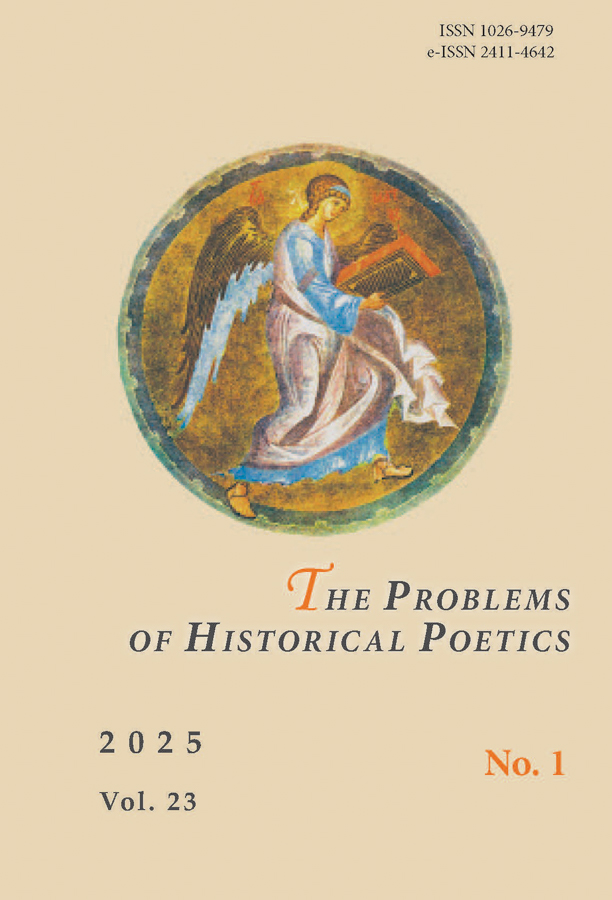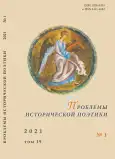A. M. Remizov’s “Theory of Russian Literary Style” (1930s‒1950s)
- Authors: Gracheva A.M.1
-
Affiliations:
- The Institute of Russian Literature (Pushkinskiy Dom), The Russian Academy of Sciences
- Issue: Vol 19, No 1 (2021)
- Pages: 347-374
- Section: Articles
- URL: https://journal-vniispk.ru/1026-9479/article/view/285306
- DOI: https://doi.org/10.15393/j9.art.2021.9062
- ID: 285306
Cite item
Full Text
Abstract
The article analyzes the stages of development of A. M. Remizov’s “theory of Russian literary style” (“teoriya russkogo lada”) in the 1930s–1950s. In the 1930s, the opportunities for the writer to present his aesthetic views in an open journalistic form narrowed down significantly. Remizov was forced to popularize his theory and the name of its “founder” — protopope Avvakum in works devoted to other topics (Knigopisets i shtanba, Po sledam protopopa Avvakuma v SSSR, etc.). In these years, the conceptual apparatus of the theory has taken shape, the semantics of the term “theory of Russian literary style” was detailed. In 1946, Remizov made the last, unsuccessful attempt to publish an introduction to his theory in the form of a manifesto (Na russkiy lad, 1946). The exposition of this theory’s postulates was an indispensable part of most of Remizov’s works of the late 1940s–1950s. Plyashuschiy Demon (The Dancing Demon), an avant-garde book, reveals the ongoing confrontation between the supporters and opponents of the “theory of Russian literary style” up to the 20th century through a historical kaleidoscope of characters from different periods of Russian history. Related novels. i. e. Uchitel muzyki (The Music Teacher) and Podstrizhennymi glazami (By Cropped Eyes) are devoted to examining the mystery of the formation of a writer’s personality, and reflect the Russian art life in the 19th-20th centuries and in the first wave of Russian emigration. The writer’s emerging personality, the formation of its aesthetic foundation is historically and culturally justified in both books. The writer in question is a follower of “theory of Russian literary style”. This very theme is one of the central topics in Remizov’s latest work — his book about himself — Litso pisatelya (The Face of a Writer).
About the authors
Alla M. Gracheva
The Institute of Russian Literature (Pushkinskiy Dom), The Russian Academy of Sciences
Author for correspondence.
Email: irliran@mail.ru
ORCID iD: 0000-0002-4708-098X
PhD (Philology), Chief Researcher
Russian Federation, Saint PetersburgReferences
- Gracheva A. M. Origins and Evolution of the “Theory of a Core Mode of the Russian Literary Style” by Alexei Remizov (1900s–1920s). In: Problemy istoricheskoy poetiki [The Problems of Historical Poetics], 2019, vol. 17, no. 3, pp. 232–257. doi: 10.15393/j9.art.2019.6101 (In Russ.)
- Orlov V. N. The Poetry of Bourgeois Decline (Symbolism, Acmeism, Futu- rism).
1. In: Istoriya russkoy literatury. Literature of 1890–1917]. Moscow, Leningrad, Academy of Sciences of the URSS Publ., 1954. Vol. 10, pp. 766–774. (In Russ.) - Pleshcheev A. A. Nash balet (1673–1896): Balet v Rossii do nachala XIX sto- letiya i balet v S.-Peterburge do 1896 goda [Our Ballet (1673–1896): Ballet in Russia Until the Beginning of the 19th Century and Ballet in St. Petersburg Until 1896]. St. Petersburg, Tipografiya A. Benke Publ., 1896. 391 p. (In Russ.)
- Pascal Pierre. Avvakum et les débuts du raskol: La crise religieuse au XVIIe siècle en Russie [Avvakum and the Beginnings of Raskol: The Religious Crisis in the 17th Century in Russia]. Paris. 1938. XXV, 619 p. (In French)
Supplementary files











